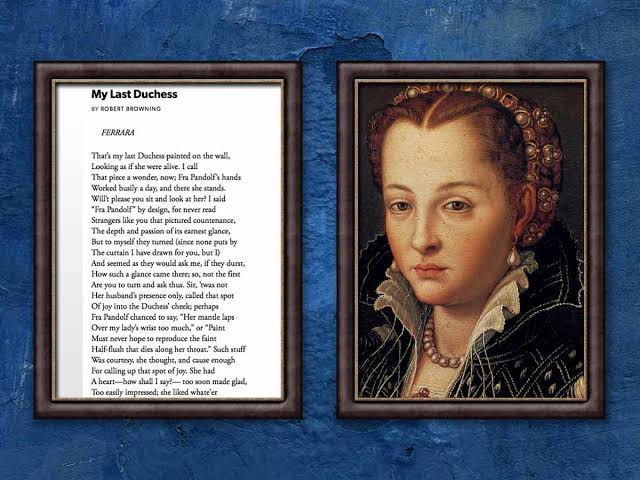Reflect on the use of symbolism in My Last Duchess. How do specific symbols, such as the painting and the “curtain” mentioned in the poem, contribute to the deeper meaning and themes?

Symbolism in My Last Duchess by Robert Browning: Exploring Meaning and Themes
Introduction:
Robert Browning‘s dramatic monologue, “My Last Duchess,” incorporates rich symbolism to enhance the reader’s understanding of the deeper meaning and themes within the poem. Through the use of symbols, such as the painting and the “curtain,” Browning delves into themes of power, control, art, and the objectification of women. This essay will examine the symbolism employed in “My Last Duchess,” exploring how these symbols contribute to the poem’s meaning and themes.
I. The Painting as a Symbol:
The painting of the Duchess plays a pivotal role in the poem, functioning as a powerful symbol that deepens the reader’s understanding of the Duke’s character and his attitudes towards women.
- The Duchess’s Representation:
The painting serves as a representation of the Duchess herself, making it a symbol of her existence and identity. Through the portrait, the Duchess is objectified, reduced to a mere image captured by the artist’s brush. The painting becomes a substitute for the Duchess, allowing the Duke to maintain control over her representation and manipulate the perception of her character.
- Objectification and Ownership:
The painting symbolizes the Duke’s objectification and possession of the Duchess. He refers to the portrait as “my Last Duchess” (line 1), highlighting his possessiveness and sense of ownership over her image. The painting serves as a tangible manifestation of his power and control, representing his ability to possess and control not just the Duchess herself but also her memory and legacy.
- Freeze of Time:
The painting’s static nature symbolizes the Duke’s desire to freeze the Duchess in a moment of subservience. Unlike a living person, the painting remains unaffected by time and change. It immortalizes the Duchess’s subservience and vulnerability, reinforcing the Duke’s desire for control and his need to perpetuate an image of her that aligns with his narrative.
II. The Curtain as a Symbol:
The curtain mentioned in the poem acts as a potent symbol that adds depth and nuance to the themes explored in “My Last Duchess.”
- Selective Display and Concealment:
The curtain represents the Duke’s desire for control and the selective nature of his self-presentation. The Duke mentions that the curtain is drawn only for special guests, implying that he has the power to decide who is granted access to the painting and when. By controlling who can view the painting, the Duke asserts his dominance over the representation of the Duchess and the narrative surrounding her.
- The Illusion of Privacy:
The curtain creates an illusion of privacy, suggesting that the Duke is willingly exposing a vulnerable and intimate part of himself to select individuals. However, this illusion is a façade that conceals the Duke’s true motives and allows him to carefully craft his narrative. The curtain symbolizes the Duke’s ability to manipulate his audience’s perception of events and to hide the darker aspects of his character and actions.
- Suppression and Control:
The presence of the curtain symbolizes the suppression and control the Duke exercises over the Duchess’s image and story. By concealing the painting, the Duke ensures that he can control how the Duchess is perceived by others. He can present a sanitized and idealized version of her, erasing any elements that may challenge his authority or tarnish his reputation.
III. Themes Explored through Symbolism:
The symbolism of the painting and the curtain contributes to the exploration of several themes within “My Last Duchess.”
- Power and Control:
The symbols of the painting and the curtain underscore the theme of power and control. The Duke’s possession of the painting reflects his desire to exert authority over the Duchess’s image and memory, reinforcing his position as a dominant figure. The selective display and concealment of the portrait highlight the Duke’s ability to control the narrative surrounding the Duchess and his relationships.
- Objectification and Dehumanization:
The symbolism of the painting serves to highlight the objectification and dehumanization of the Duchess. She becomes reduced to a static image, robbed of her agency and voice. The Duke’s possessive language and his insistence on referring to the portrait as “my Last Duchess” reinforce this objectification, reducing her to a mere possession or trophy.
- Appearance versus Reality:
The symbolism of the painting and the curtain explores the theme of appearance versus reality. The Duke carefully crafts his narrative and controls the representation of the Duchess, presenting an image that aligns with his desires and hides the truth of their relationship. The symbols remind the reader that what is presented may not necessarily reflect the reality of a situation, highlighting the façade maintained by the Duke.
- Art and its Power:
The painting serves as a representation of art’s power and its potential to perpetuate narratives. It highlights the role of art in shaping perception and the ability of artists and their subjects to be objectified and controlled through artistic representation. The symbolism of the painting calls attention to the complex relationship between art, power, and the objectification of individuals.
Conclusion:
In “My Last Duchess,” Robert Browning employs symbolism to deepen the reader’s understanding of the poem’s meaning and themes. The painting and the curtain serve as potent symbols, reflecting the Duke’s desire for power, control, and the objectification of the Duchess. The symbols contribute to the exploration of themes such as power dynamics, objectification, appearance versus reality, and the role of art in shaping perception. By incorporating these symbols, Browning invites readers to critically engage with the poem, questioning the nature of power, control, and the manipulation of representation within relationships and artistic expressions.
*****
Read More:
Question and Answers from My last Duchess by Robert Browning

